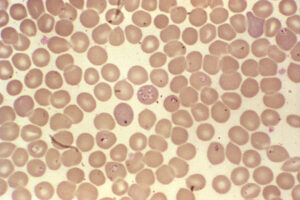Call for your appointment today 914-666-4665 | Mt. Kisco, New York

by Daniel J. Cameron, MD MPH
The importance of clinicians considering other tick-borne diseases, such as Babesia, when evaluating patients with Lyme disease has been addressed in the literature. Surprisingly, however, physicians may actually not consider Borrelia burgdorferi (the Lyme pathogen) as a “co-infection” in patients diagnosed with a tick-borne disease. Such was the case for an elderly man diagnosed with Babesia, who also had Lyme disease which was almost overlooked, according to a case report by Zaiem and colleagues.
The case report serves as a reminder to practitioners that as the number of reported cases of tick-transmitted diseases grows, Lyme disease should also be on their radar as a co-infection. For years, Lyme disease has been overlooked as a possible cause behind patients’ symptoms.
One study by Dr. Brian Fallon and colleagues found Lyme disease was overlooked an average of 2 years in patients who were later diagnosed with Lyme encephalopathy [1] and a series of patients who were thought to suffer from a psychiatric illness. [2] The undiagnosed Lyme patients with psychiatric illness were initially presumed to suffer from “paranoia, dementia, schizophrenia, bipolar disorder, panic attacks, major depression, anorexia nervosa, and obsessive-compulsive disorder.” [2]
According to a case series by Dr. Daniel Cameron, there were Lyme disease patients whose illness overlooked for a years before they were diagnosed with and serologically confirmed with 5 out of 10 positive IgG western blot bands. [3]
The patients in the case series included:
1) 34-year-old man with an erythema migrans (EM) rash, who was tested 1 week after the rash appeared but was ill for 8 years;
2) 16-year-old young woman with Epstein barr and strep infection, who was ill for 8 years;
3) 57-year-old man with a tick bite, followed by a swollen right knee, which was presumed to be a meniscus tear, who was ill for 6 years;
4) 16-year-old boy, who presented with Bell’s palsy and complained of performing poorly in school, who was ill for 6 years;
5) 35-year-old man, who exhibited symptoms consistent with LD but was told by two clinicians that he did not have Lyme, remained ill for 3 years.
6) 42-year-old woman, whose spinal tap results were negative, was ill for 3 years. [3]
A delay in treatment can be concerning since it has been associated with poor outcomes for Lyme disease patients. For instance, Lyme encephalopathy patients, who were overlooked for an average of two years in the Fallon study, remained sick an average of 9 years after onset of illness. [1] Patients in the Cameron case series study, who experienced treatment delays, were 6 times more likely to fail their initial course of treatment than Lyme disease patients, who were treated within 30 days of onset. [3]
Borrelia as a co-infection
“Co-infection with Borrelia should be considered in patients with atypical presentation or with a poor response to proper therapy,” concludes Zaiem. [4] A case report, published in QJM: An International Journal of Medicine, describes a 70-year-old man, who presented to the emergency room with a 4-day history of headaches, high fevers, non-bilious vomiting and low urine output. Babesia was considered based on a 6-month history of living with his daughter in Eastern Long Island, NY. Malaria was also considered given he had emigrated from Bangladesh just 6 months prior to becoming ill.
Laboratory tests supported the Babesia diagnosis. “Peripheral blood smear revealed intracellular ovoid rings resembling both Plasmodium sp. and B. microti rings,” states Zaiem. The PCR test came back positive for B. microti and the patient was started on a 7-day treatment with doxycycline and quinine to cover either infection. He showed improvement in both symptoms and laboratory findings.
Just prior to being discharged from the hospital, the man developed Bell’s palsy. He was tested and found to be positive for Bb and he was diagnosed with Lyme disease. The infection would have most likely been missed had the patient not developed Bell’s palsy – a symptom that only 9% of LD patients exhibited in the CDC’s surveillance database. [4]
Illnesses transmitted by ticks can be complex. The importance in providing follow-up evaluations with patients treated for tick-borne diseases cannot be understated. Gathering detailed and thorough medical histories is equally as critical, as factors not considered important by the patient, may impact disease presentation. For instance, Lyme patients may have taken antibiotics prior to their evaluation that could abrogate their immune response. [5-14]
Given the growing number of studies finding ticks capable of harboring more than one disease-causing agent, LD needs to be considered in patients who have a documented tick-borne illness. A 2014 study found B. burgdorferi was detected in 55% of the ticks collected in an upstate New York region, followed by A. phagocytophilum (18.2%), B. microti (3.2%), and E. chaffeensis (1.5%). [15]
Lyme disease needs to be considered in individuals with Babesia. [16-23]. Krause and colleagues described an increased illness severity if both Babesia and LD were present. [24] Steere and colleagues reported patients with LD and Ehrlichia or Babesia tend to have more symptoms, in addition to fevers and chills, than patients who did not. [25]
Co-infections and treatment outcome
An infection with more than one tick-borne infection can affect outcome. Krause concluded: “Physicians should consider use of tests designed to diagnose Babesiosis and HGE in patients with Lyme disease who experience a prolonged flu-like illness that fails to respond to appropriate antimicrobial therapy.” [26] Transverse myelitis [27] and a fatal pancarditis [28] are examples of poor outcomes in patients with both Lyme disease and Babesiosis.
Zaiem and colleagues remind clinicians: “When patients present with malaria- like illness in the areas endemic for Babesia infection, physicians should keep Babesiosis high on their differential list. Co-infection with Borrelia should be considered in patients with atypical presentation or with a poor response to proper therapy.” [4]
References:
- Fallon BA, Keilp JG, Corbera KM et al. A randomized, placebo-controlled trial of repeated IV antibiotic therapy for Lyme encephalopathy. Neurology, 70(13), 992-1003 (2008).
- Fallon BA, Nields JA. Lyme disease: a neuropsychiatric illness. Am J Psychiatry, 151(11), 1571-1583 (1994).
- Cameron DJ. Consequences of treatment delay in Lyme disease. J Eval Clin Pract, 13(3), 470-472 (2007).
- Zaiem F, Alkawam H, Lee S, Fabisevich M. Severe Symptomatic Babesiosis Co-infection with Lyme Disease. QJM, (2015).
- Brunner M, Sigal LH. Use of serum immune complexes in a new test that accurately confirms early Lyme disease and active infection with Borrelia burgdorferi. J Clin Microbiol, 39(9), 3213-3221 (2001).
- Schutzer SE, Coyle PK, Belman AL, Golightly MG, Drulle J. Sequestration of antibody to Borrelia burgdorferi in immune complexes in seronegative Lyme disease. Lancet, 335(8685), 312-315 (1990).
- Singh SK, Girschick HJ. Lyme borreliosis: from infection to autoimmunity. Clin Microbiol Infect, 10(7), 598-614 (2004).
- Dattwyler RJ, Volkman DJ, Luft BJ, Halperin JJ, Thomas J, Golightly MG. Seronegative Lyme disease. Dissociation of specific T- and B-lymphocyte responses to Borrelia burgdorferi. N Engl J Med, 319(22), 1441-1446 (1988).
- Steere AC. Seronegative Lyme disease. Jama, 270(11), 1369 (1993).
- Dressler F, Yoshinari NH, Steere AC. The T-cell proliferative assay in the diagnosis of Lyme disease. Ann Intern Med, 115(7), 533-539 (1991).
- Schutzer SE, Coyle PK, Reid P, Holland B. Borrelia burgdorferi-specific immune complexes in acute Lyme disease. Jama, 282(20), 1942-1946 (1999).
- Brunner M. New method for detection of Borrelia burgdorferi antigen complexed to antibody in seronegative Lyme disease. J Immunol Methods, 249(1-2), 185-190 (2001).
- Kantor FS. Disarming Lyme disease. Sci Am, 271(3), 34-39 (1994).
- Ang CW, Notermans DW, Hommes M, Simoons-Smit AM, Herremans T. Large differences between test strategies for the detection of anti-Borrelia antibodies are revealed by comparing eight ELISAs and five immunoblots. Eur J Clin Microbiol Infect Dis, (2011).
- Aliota MT, Dupuis AP, 2nd, Wilczek MP, Peters RJ, Ostfeld RS, Kramer LD. The prevalence of zoonotic tick-borne pathogens in Ixodes scapularis collected in the Hudson Valley, New York State. Vector Borne Zoonotic Dis, 14(4), 245-250 (2014).
- dos Santos CC, Kain KC. Two tick-borne diseases in one: a case report of concurrent babesiosis and Lyme disease in Ontario. Cmaj, 160(13), 1851-1853 (1999).
- Swanson SJ, Neitzel D, Reed KD, Belongia EA. Coinfections acquired from ixodes ticks. Clin Microbiol Rev, 19(4), 708-727 (2006).
- Thompson C, Spielman A, Krause PJ. Coinfecting deer-associated zoonoses: Lyme disease, babesiosis, and ehrlichiosis. Clin Infect Dis, 33(5), 676-685 (2001).
- Hunfeld KP, Hildebrandt A, Gray JS. Babesiosis: recent insights into an ancient disease. Int J Parasitol, 38(11), 1219-1237 (2008).
- Aguero-Rosenfeld ME. Laboratory aspects of tick-borne diseases: lyme, human granulocytic ehrlichiosis and babesiosis. Mt Sinai J Med, 70(3), 197-206 (2003).
- Lotric-Furlan S, Ruzic-Sabljic E, Strle F. Concomitant human granulocytic anaplasmosis and Lyme neuroborreliosis. Clin Microbiol Infect, 15 Suppl 2, 28-29 (2009).
- Doudier B, Olano J, Parola P, Brouqui P. Factors contributing to emergence of Ehrlichia and Anaplasma spp. as human pathogens. Vet Parasitol, 167(2-4), 149-154 (2010).
- Wakeel A, Zhu B, Yu XJ, McBride JW. New insights into molecular Ehrlichia chaffeensis-host interactions. Microbes Infect, 12(5), 337-345 (2010).
- Krause PJ, Telford SR, 3rd, Spielman A et al. Concurrent Lyme disease and babesiosis. Evidence for increased severity and duration of illness. Jama, 275(21), 1657-1660 (1996).
- Steere AC, Dhar A, Hernandez J et al. Systemic symptoms without erythema migrans as the presenting picture of early Lyme disease. Am J Med, 114(1), 58-62 (2003).
- Krause PJ, McKay K, Thompson CA et al. Disease-specific diagnosis of coinfecting tickborne zoonoses: babesiosis, human granulocytic ehrlichiosis, and Lyme disease. Clin Infect Dis, 34(9), 1184-1191 (2002).
- Oleson CV, Sivalingam JJ, O’Neill BJ, Staas WE, Jr. Transverse myelitis secondary to coexistent Lyme disease and babesiosis. J Spinal Cord Med, 26(2), 168-171 (2003).
- Marcus LC, Steere AC, Duray PH, Anderson AE, Mahoney EB. Fatal pancarditis in a patient with coexistent Lyme disease and babesiosis. Demonstration of spirochetes in the myocardium. Ann Intern Med, 103(3), 374-376 (1985).




